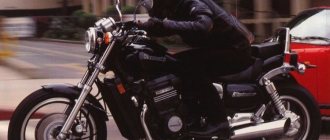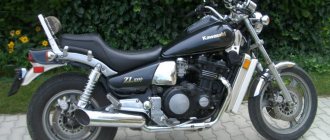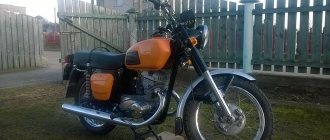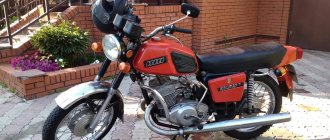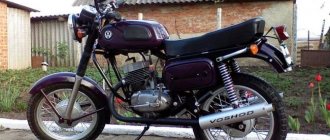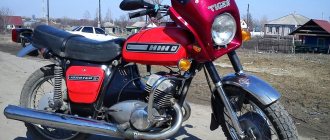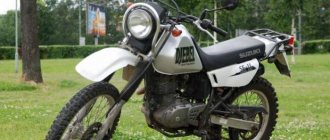The Kawasaki ZL 1000 Eliminator is identical to the ZL 400 in everything except its engine. The latter, although deformed, belongs to the sports category. The rest is classic, including the fit. Here is a sports cruiser that is suitable for people no taller than average.
The bike has a number of advantages, and its small size can be attributed to them to some extent. The Kawasaki ZL 600 Eliminator motorcycle, maneuverable at high speeds, is capable of overcoming obstacles due to its fairly large traction and is generally very strong, although it is difficult to tell by looking at it.
Engine
The four-stroke engine is of the in-line type. This engine is not simple, it was borrowed from a sports motorcycle of the same concern - Kawasaki GPZ 600.
The engine shows excellent results: peak torque is 46 Newton meters, while maximum power exceeds 60 horsepower.
The RPM at which this beast reaches its full potential is 7,000 rpm. Acceleration is truly impressive: in just 3.5 seconds the motorcycle can accelerate to 100 kilometers per hour. And this makes it, in a sense, a competitor to such a monster as the Honda VTX 1800.
The maximum speed of this Kawasaki is approximately 180 kilometers per hour.
Specifications
Technical characteristics of Kawasaki ZL600 Eliminator:
| Model | Kawasaki ZL600 Eliminator |
| Motorcycle type | power cruiser (dragster) |
| Year of issue | 1986-1987 (ZL600-A); 1995-1997 (ZL600-B) |
| Frame | steel duplex |
| engine's type | 4-cylinder, 4-stroke, in-line |
| Working volume | 592 cm³ |
| Bore/Stroke | 60.0 x 52.4 mm |
| Compression ratio | 11.0:1 |
| Cooling | liquid |
| Number of valves per cylinder | DOHC chain drive, 4 valves per cylinder |
| Fuel supply system | Carburetor, 4x Keihin CVK30 |
| Ignition type | transistor |
| Maximum power | 74.0 hp (54.4 kW) at 10,500 rpm – ZL600A 58.0 hp (42.7 kW) at 7500 rpm – ZL600A (Switzerland) |
| Maximum torque | 53.9 Nm (5.5 kg*m) at 8500 rpm – ZL600A 54.9 Nm (5.6 kg*m) at 7000 rpm – ZL600A (Switzerland) |
| Clutch | Multi-disc in oil bath, cable drive |
| Transmission | 6-speed |
| type of drive | cardan |
| Front tire size | 100/90-18 (56H) |
| Rear tire size | 150/80-15 (70H) |
| Front brakes | 1 disc, 280 mm, 1-piston caliper – ZL600A 1 disc, 300 mm, 2-piston caliper – ZL600B |
| Rear brakes | drum |
| Front suspension | 37mm KYB telescopic fork (pneumatic), 145mm travel – ZL600A 37mm telescopic fork, 150mm travel – ZL600B |
| Rear suspension | pendulum with two shock absorbers (pneumatic, adjustable preload and rebound), stroke - 108 mm - ZL600A pendulum with two shock absorbers (5-stage adjustable preload), stroke - 100 mm - ZL600B |
| Motorcycle length | 2240 mm – ZL600A (Europe) 2210 mm – ZL600A (North America) 2230 mm – ZL600B |
| Motorcycle width | 795 mm – ZL600A (Europe) 775 mm – ZL600A (North America) 720 mm – ZL600B |
| Motorcycle height | 1065 mm – ZL600A (Europe) 1120 mm – ZL600A (North America) 1090 mm – ZL600B |
| Wheelbase | 1550 mm |
| Seat height | 720 mm – ZL600A 715 mm – ZL600B |
| Minimum ground clearance (clearance) | 145 mm |
| Acceleration 0-100 km/h (0-60 mph) | 3.83 sec[1] |
| Maximum speed | 183 km/h[2] |
| Gas tank capacity | 12.3 l – ZL600A 13.0 l – ZL600B |
| Motorcycle weight (dry) | 195 kg – ZL600A 197 kg – ZL600B |
| Motorcycle weight (curb) | 211 kg – ZL600A 213 kg – ZL600B |
Dimensions and weight
In terms of its dimensions, the motorcycle will be smaller than many 400 cc ones. This makes it maneuverable and suitable for urban environments. Corresponds to the dimensions and curb weight of the motorcycle. But there is a certain risk in this: for a beginner, such a light bike with suboptimal brakes and a powerful engine can become dangerous.
Brief history of the model
- 1986 - start of production and sales of the model. First generation
.
Model
: Kawasaki ZL600 Eliminator (Europe, North America).
Factory designation
: ZL600-A1.
- 1987 - no significant changes.
Model
: Kawasaki ZL600 Eliminator (Europe, North America).
Factory designation
: ZL600-A2.
- 1995 - restyling of the model. Second generation
.
Model
: Kawasaki ZL600 Eliminator (Europe, North America).
Factory designation
: ZL600-B1.
- 1996 - no significant changes.
Model
: Kawasaki ZL600 Eliminator (Europe, North America).
Factory designation
: ZL600-B2.
- 1997 is the last year of production.
Model
: Kawasaki ZL600 Eliminator (Europe, North America).
Factory designation
: ZL600-B3.
So I got to this resource :-) It all started in 2013, when I bought my first Kawasaki Eliminator 400 motorcycle... Although no, it all probably started much earlier, in 2008... Since this is my first post, everything turns out a little chaotic. So, in 2008, when I was still in school, the opportunity arose to attend the so-called “moto club”, the ultimate goal of which was to obtain a category “A” license. This event worked on the principle: if you want to ride, fix it. Since all the scooters were taken after being scrapped. What I mean is that I have had good experience with technology, although mostly with two-stroke machines. I still got my license, and even bought an old Java 350, but due to entering university and moving to St. Petersburg, I never had the chance to drive it. Well, then things started to happen... New city, study, work, and where does the student get the money. In general, I went and licked my lips at various motorcycles, of which there are plenty in St. Petersburg in the summer. By 2013, he had settled down and saved some money, but the level of motor toxicosis began to go off scale! Having borrowed a little more money from a friend, I began to look for something for my budget, which amounted to, just don’t laugh, 70 kilo rubles. I approached the issue responsibly, bought a helmet and a “garage”, or rather a rotten shed with a hole in the roof in a collective parking lot. As you understand, such a budget was suitable for either something very shaggy years old, or something very small and Chinese, and given that I wanted something else beautiful and shiny with a lot of chrome, the initial choice fell on the Ymaha Virago 400. Overall, the motorcycle satisfied the requirements: beautiful, with a classic fit, the cardant was considered a very big plus, and besides, it’s a v-twin, scabies, which is very cool (as it seemed to me then). I even managed to find a copy that fit my budget and negotiated a purchase, but the owner disappeared somewhere. It turned out that it was difficult to find something else like this in the middle of the season, but I steadily monitored the corresponding resources in search of a budget option, even began to look at the Urals of 2007-9, but found them too heavy and high-volume to begin with. And what luck! 89t.r. Eliminator 400. What is it? Never heard. I quickly read reviews and specifications. Outwardly attractive, again a cardan, faster and more powerful than Viraga. I went to look at the food, negotiated down to the available amount and bought it the next day. Everything happened somehow quickly and impulsively. Photo immediately after purchase
But miracles don’t happen... While the ILO was waiting for registration with the MREO code, a puddle of gasoline formed. There is no such thing as cheap equipment in perfect condition. Then there were repeated disassembly and reassembly of the carbs, searching for the reasons. The difficulty was that the available experience was not enough; during the first season, I saw Lum assembled less often than disassembled. But thanks to this motorcycle, I met a very good man who became my reliable friend.
This is some simple humor
Thank you Sanya for your help and thank you to the eliminator forum for this introduction and support regarding materiel. I fiddled with it for a long time, but it was of little use. In a word, I didn’t go to the closing of the season. It so happened that it arrived in my garage, because... Sashka purchased a liter Eliminator. Therefore, a decision was made to sell my lum, despite the fact that I took his scabies in installments.
I bought this beauty
In the background is Eliminator 1000 and its owner.
The season was active, more on that later. But I sold my first Eliminator for a long time and finally sold it at the very end of summer. Also during this season I finally realized what I was thinking about back in that season: I want to drive and not think about the quality of the road surface! And this will be the next story...
And another photo of the Elminators PS: I want to believe that someone will be interested in this information, and maybe even useful
Kawasaki ELIMINATOR - a brief history of the series
The Eliminator series appeared in 1985 in the line of the Japanese motorcycle manufacturer Kawasaki. The motorcycles of this series were conceived as “Sport Cruisers”, and therefore sports motorcycles became the donors (in terms of the engine). At one time, the first-born, the EL 900, made a splash and, before the release of the legendary Yamaha V-max, was the most desired motorcycle of Japanese and American bikers. Kawasaki ZL-900 Eliminator (1985-1986) - this model appeared in 1985 and made a splash on the global motorcycle market, as it became the first mass-produced sports cruiser.
Kawasaki ZL-900 Eliminator
The engine came from the GPz900R Ninja model. It was redesigned, and the result was the following: Engine: volume: 908 cm3; cylinders: 4; arrangement: row; power: 105 hp, at 9500 rpm; food: carburetor x4; starting: electric starter; gearbox: 6 speeds; cooling: liquid.
Complaints about the engine include a tendency to overheat (therefore, it is not advisable to show off the bike while standing in one place with the engine running) and also gluttony (you need to look for a gas station every 150 km). Among the features of the motorcycle, we can highlight: rear wheel drive using a cardan, low seating and a correspondingly low center of gravity, as well as very dynamic acceleration. Even now, this concept of a motorcycle (chassis from a cruiser, engine from a sport) is considered something special, let alone in the eighties, experts say that the Kawasaki ZL-900 Eliminator was way ahead of its time! But it didn’t take him long to be the very best, as the Yamaha V-max appeared (the advertising department of the Yamaha company did their job professionally and cleanly, but that’s another story).
Kawasaki ZL-1000
Two years later, the ZL-900 was replaced by the ZL-1000. This model is evolutionary and there are not many stylistic changes (increased fuel tank, modified fenders and seats). But this time, the engine donor was the ZG1000 Concours (in Europe known under the brand name GTR1000 - sport tourist). Engine: volume: 997 cm3; cylinders: 4; arrangement: row; power: 110 hp, at 9000 rpm; food: carburetor x4; starting: electric starter; gearbox: 6 speeds; cooling: liquid.
Kawasaki ZL-1000 Eliminator
This model was produced even less, only one year, but it can still be found on the secondary motorcycle market in Japan.
Kawasaki ZL-750
As an alternative to the “big brothers”, a model with a smaller engine capacity was created - the ZL750. This model was produced from 1986 to 1989.
Kawasaki ZL-750 Eliminator
Kawasaki ZL-600
In 1986, the ZL600 was released. This model was positioned (like the ZL750) as a smaller alternative to its big brothers. The engine donor was the Ninja-600 model. Engine: volume: 592 cm3; cylinders: 4; arrangement: row; power: 74 hp, at 10500 rpm; food: carburetor x4; starting: electric starter; gearbox: 6 speeds; cooling: liquid.
Kawasaki ZL-600 Eliminator
In the press of that time, one could note notes of surprise and joy that, in the theme of “small cruisers,” a motorcycle with a sports bike engine appeared! Agree, now it would look no less cool (a cruiser with an engine from the ZX-6R))).
Kawasaki ZL-500
Little is known about this model. This model has all the features of its brothers, including the appearance and engine concept. Engine: volume: 497 cm3; cylinders: 4; arrangement: row; food: carburetor x4; starting: electric starter; cooling: liquid.
Kawasaki ZL-400
A very popular model on the Russian and Japanese secondary markets. The motorcycle was produced for eight years (1986-1994), during which time several modifications were released (they differed in stylistic changes and minor technical ones - rims, brakes, coloring, drive). On the Internet, you can order many tuning parts for this model. There is a big difference between this model and its older brothers - the drive to the rear wheel is carried out using a chain drive (there are modifications with a belt drive). Engine: volume: 398 cm3; cylinders: 2; arrangement: row; power: 54 hp, at 12000 rpm; food: carburetor x2; starting: electric starter; cooling: liquid.
Kawasaki ZL-400 Eliminator
The cost of this motorcycle model on the secondary market is ~ 80,000-100,000 rubles.
Kawasaki EL-250
Model EL250 was released in 1987. The engine came from the GPX-R 250. As in the 400, instead of a cardan, a chain drive was used on the rear wheel. Engine: volume: 398 cm3; cylinders: 2; arrangement: row; power: 35 hp, at 9500 rpm; food: carburetor x2; starting: electric starter; cooling: liquid.
( added : The Kawasaki Eliminator 250V model has a V-engine with a cylinder angle of 90 degrees, 4 valve heads, 38 horses and a maximum of 12500 rpm, produced from 1998 to the present in Japan, but export is complicated, because because for 250 cubic meters they don’t issue PTS)
Kawasaki EL-250 Eliminator
Kawasaki EL-125
The only model from the Eliminator family that remains in the Kawasaki program is the EL125. This bike is positioned as an entry-level motorcycle. According to European legislation (I don’t know for sure about American legislation), drivers with category B have the right to ride motorcycles with an engine capacity of up to 125 cm3, so thrifty Europeans readily take them. An engine with no pretensions to sport,... just an engine))
Kawasaki EL-125 Eliminator
Conclusion: This family of motorcycles has been in production for a very long time, and clubs for Eliminator connoisseurs can now be found all over the world. In Russia they were also very popular because of their ease of maintenance and low price, especially the ZL400 model. Unfortunately, at one time, these motorcycles were not featured in any big-budget film (unlike the V-MAX), which is a big omission of the Kawasaki PR people. More recently, Yamaha Corporation updated its bestseller – V-MAX, and who knows, maybe the specialists from Kawasaki will remember the legendary ELIMINATOR line.
